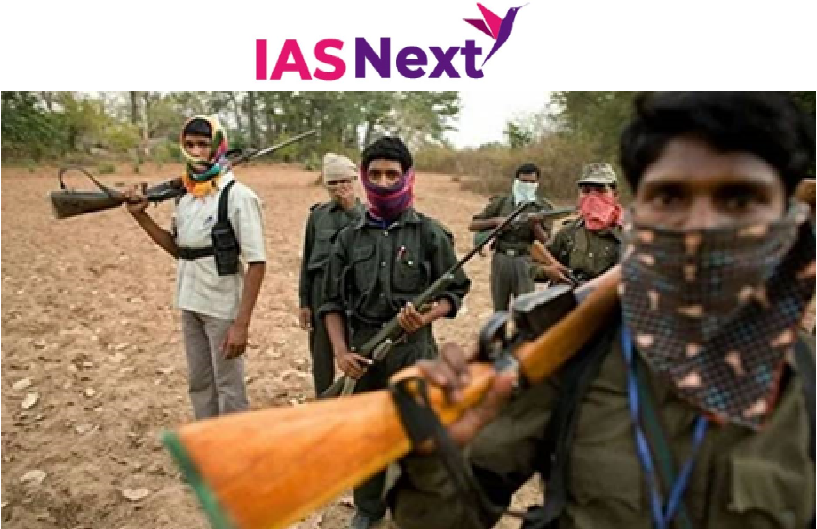CURRENT AFFAIRS
Get the most updated and recent current affair content on Padhaikaro.com
Naxalism /Insurgency threat in India
- IAS NEXT, Lucknow
- 28, Oct 2021

The term ‘Naxal’ derives from the name of the village Naxalbari in West Bengal, where the movement had its origin.
Naxalbari uprising was an armed peasant revolt in 1967 in the Naxalbari block of the Siliguri subdivision in Darjeeling district, West Bengal, India.
It was mainly led by tribals and the radical communist leaders of Bengal and further developed into Communist Party of India (Marxist–Leninist) in 1969.
The event became an inspiration to the naxalite movement which rapidly spread from West Bengal to other states of India creating division within the Communist Party of India (Marxist) (CPI(M)) party.
The Naxals are considered far-left radical communists, supportive of Maoist political sentiment and ideology.
Initially the movement had its centre in West Bengal.

The insurgency started in 1967 in the Naxalbari village of West Bengal by a radical faction of the CPI-M led by Charu Majumdar, Kanu Sanyal, and Jangal Santhal dubbed the Naxalbari uprising.
In later years, it spread into less developed areas of rural southern and eastern India, such as Chhattisgarh, Odisha and Andhra Pradesh through the activities of underground groups like the Communist Party of India (Maoist).
For the past 10 years, it has grown mostly from displaced tribal’s and natives who are fighting against exploitation from major Indian corporations and local officials whom they believe to be corrupt.
Left-wing extremism has been a major threat to India since the 1960s. Many of these Insurgent groups, for many years, had held the mineral-rich lands under their influence.
Both the states and Central government, through a series of measures, had significantly improved their presence in the Naxal-infested regions. Currently, these militant groups are only operating in a few isolated regions. However, they still pose a substantial threat to India’s national security.
What are the causes of Naxalism?
Tribal discontent:
- The Forest (Conservation) Act, 1980 deprives tribals, who depend on forest produce for their living, from even cutting a bark.
- Massive displacement of tribal population in the naxalism-affected states due to development projects, mining operations and other reasons.
- In fact 80% of the total displaced persons within the period of 1947 – 2000 were tribal’s.
- A large number of tribal’s were not regarded by state services as well as governmental development projects. Attempts by the states to increase its influence in the most backward areas resulted in repression of the inhabitants by state authorities such as by the forest departments and subsequently resulted in the destruction of their traditional social bond.
- The most Naxal affected areas Jharkhand, Bihar, Chhattisgarh, Madhya Pradesh, and Andhra Pradesh are rich in natural resources.
- In this area, natural resources are not only reason of promoting Naxalite movement. It could be one of the reasons, but not the only reason. It is doubtful whether it could be considered even as the primary reason.
Easy Target for Maoists: Such people who do not have any source of living are taken into naxalism by Maoists. Maoists provide arms and ammunitions and money to such people.
The Maoists have a significant presence in the states of Chhattisgarh, Orissa, Andhra Pradesh, Maharashtra, Jharkhand, Bihar, and West Bengal, and a marginal presence in Assam, Madhya Pradesh and Uttar Pradesh.
The Maoists assert that they are defending the rights of the marginalized: the poor, the landless, Dalits, and tribal indigenous communities. They call for a revolution, demanding a radical restructuring of the social, political, and economic order.
Gaps in the socio-economic system of the country:
- Government measuring its success on the basis of number of violent attacks rather than the development done in the naxal-affected areas.
- lack of human development causes anger and resentments amongst the people. They feel alienated and excluded. In addition, often local elites are engaged in exploiting, harassing and even torturing the tribal population.
- The conflict between economic progress and aboriginal land rights continues to fuel the Naxalite’s activities. Their strongest bases are in the poorest areas of India.
- Infrastructural problems, for instance, some villages are not yet connected properly with any communication network.
Haphazard tribal policy implementation, marginalisation, and displacement of the tribal communities worsened the situation of Naxalism. The increase in the interregional and intraregional differences and inequalities led to people choosing Naxalism. Naxal-groups mostly consist of the poor and the deprived like the anglers, small farmers, daily labourers, etc. The government policies have failed to address this issue.
Lack of industrialisation, poor infrastructure growth and unemployment in rural areas led to disparity among the people living in these areas. This has led to an anti-government mindset among the locals in the isolated villages.
The poor implementation of the land reforms has not yielded the necessary results. India’s agrarian set up is characterized by the absence of proper surveys and other details. Due to this reason, it has greatly damaged the rural economy and anti-government sentiments were high among those who were deprived and exploited by the local landowners.
Forest cover in India is the main area of operation for these groups. The government is facing difficulties while dealing with the insurgents due to the lack of accessibility to these areas.
The unemployed youth in India is one of the major supporters of the Naxalism movement. This group mostly consists of medical and engineering graduates. The universities have become one of the major breeding grounds for radical ideologies.
How did the government respond to it?
Government Measures to Counter Naxal Violence
The government has taken up a holistic approach to tackling the Naxal problem. It has used security-related interventions coupled with developmental measures to root out the violent uprisings.
The D Bandopadhyay Committee (2006) highlighted the lack of governance, economic, socio-political and cultural discrimination against the tribals as the chief reason for the spread of Naxalism.
The Committee recommended tribal-friendly land acquisition and rehabilitation as a means to counter this issue.
- In May 2017, the Government of India allocated Rs 11,000 crores to build road connectivity in 44 districts affected by Maoist’s activities.
- Under the current Government, by 2018, 1326 km of roads were constructed in Bastar, Rajnandgaon, and Surguja areas, the highly Naxal infested areas of Chhattisgarh.
- 995 bridges were constructed and 138 of them were in the worst affected area – Bastar.
- The annual budget of the Public Works Department in Chhattisgarh was Rs 7795 crores in 2016-17.
- Roads and bridges were constructed in Sukma, another area massively hit by Naxalism.
- Local villagers are being provided with basic facilities like healthcare, education and more employment opportunities.
- Due to developmental activities and choking the funding of Naxalism, there was a spike in surrenders in Jharkhand from 676 in 2014 to 1442 in 2016.
Operation SAMADHAN
Samadhan stands for
S- Smart Leadership,
A- Aggressive Strategy,
M- Motivation and Training,
A- Actionable Intelligence,
D- Dashboard Based KPIs (Key Performance Indicators) and KRAs (Key Result Areas),
H- Harnessing Technology,
A- Action plan for each Theatre,
N- No access to Financing.
The policy was initiated in 2015 as a multidimensional approach to tackle LWE.
The chief objective of the approach is to ensure participatory governance and protection of the rights of the tribal people.
Police forces in Naxal-affected areas are fortified with more weapons, manpower, helicopters, UAVs (unmanned aerial vehicles), etc. to be more effective in their fight against Naxalism.
The government is also focussing on building better infrastructure and connectivity in the regions.
The Maoists take advantage of the weak coordination among states in the inter-state borders and set up bases there. Hence, the government is setting up joint task forces to ensure better coordination and intelligence sharing among the states.
In the Naxal belt, more fortified police stations are being set up.
The Indian Army or specialised forces such as the Greyhounds will train the police forces fighting the Naxals.
It is clear that the Maoists do not want development to take place, which is clear by their targeting schools and communication channels. Whatever their goals, they are now armed insurgency groups intended only to capture power to serve their own interests.
The government has initiated a host of tribal development schemes aimed at bringing social, economic, cultural and educational inclusion for the tribal population into the mainstream. You can get all the information on government schemes here.
The government has to tackle certain challenges in dealing with the Naxals. The Naxal groups have frequently lent moral support to insurgent groups in J&K.
It is also suspected that Pakistan’s ISI is trying to influence these groups through the land border with Nepal. This has serious implications for the country’s security. Proper intelligence inputs coupled with the adequate fortification of security forces should be done.
Along with these, sufficient and speedy development should be brought about in the worst-affected areas as only this will render the Maoists insignificant. As long as there is disillusionment with the authorities, such elements will always find sympathizers among sections of the people. Hence, to root out the problem in its entirety, proper inclusive development should be ushered in.
Counter Operations by Center or State Government
Grey Hound Police – The Greyhounds are an elite commando force of Andhra Pradesh created to combat left-wing extremists. It is considered the best anti-Naxalite force in the country. Greyhound is a simple but effective organization and recruits the best of the best from the Andhra Pradesh Police.
The Force is also known for its guerrilla approach and its functioning in the field, which is near similar to that of the Maoists.
The commandos of Greyhounds undergo rigorous training and have a strict day-to-day combat regime. Greyhound commandos often exclaim that their strength does not lie in them being a special force with special training, but it lies in the fact that it is more of a guerrilla force than a special force.
Salwa Judum – So called People’s movement was named Salwa Judum, to mean, “Peace hunt” in the local Gondi tribal dialect. The movement was launched by a few villagers angered by Naxal interference in the local trade of tendu leaves (used for making bidis).
However, later on, it was alleged that maintaining law and order in Dantewada and Bastar was outsourced to the Salwa Judum cadres, some of them as young as 15–16 years in age. Some 5000 such cadres were made Special Police Officers (SPOs).
Poorly trained, ill-equipped, and immature, some of the Salwa Judum cadres themselves looted many tribal villages. It resulted in a civil war-like situation in these regions.
Later, Supreme Court ruled that this movement is unconstitutional and only states have the responsibility of maintaining law and order.

peration Green Hunt – It was the name used by the Indian media to describe the “all-out offensive” by the government of India’s paramilitary forces and the state’s forces against the Naxalites. The operation is believed to have begun in November 2009 along with five states in the Red Corridor. The attack on the CRPF battalion is said to be in retaliation against this operation.
Surrender Policy –

Naxal-affected states have also announced surrender policies. The Jharkhand government offered Rs 50000 to surrendered Naxalites plus a monthly allowance of Rs.2000, one acre of agricultural land, and educational and health benefits to their children. The Chhattisgarh government offered up to Rs.3 lakh for weapon surrender. The Orissa government announced Rs. 10000 for surrender, Rs.20000 for arms surrender, and Rs 2 lakh of bank loan without interest for two years. But there is no effective intelligence mechanism to identify Naxal cadres . Often, tribal youths surrender as Naxal cadres; many of them even join the Naxal movement to reap these benefits.
Way Forward
The complexity of the causes of the Naxalite problem as well as its implications both for internal and external security reflect a solution that is multi-dimensional and calls for a synergy between the central governments and the states. In order to comprehensively dissolve the Naxalite threat, the government has to address its root causes.
Socio-economic alienation and the dissatisfaction with the widening economic and political inequality will not be solved by military force alone, which seems to be the main instrument employed by the government. The problem calls for a three-pronged solution: social and economic development, multi-lateral dialogue and military force.
Socio-economic development: As the Naxalites are fueled by discontent from the marginalized and the poor, a larger percentage of the national budget must be allocated to addressing the needs of these regions. More of the national expenditure needs to be focused on developing these poorer regions through initiatives regarding health, education, social welfare and rural and urban development.
Government service delivery should be improved in these tribal areas. Both state and government must ensure that things such as statutory minimum wages, access to land and water sources initiatives are implemented. In coming up with strategies for national economic growth, the government must always bear in mind the possible effects of fast growth for all socio-economic groups in a country as large and diverse as India. If the social needs of these marginalized people are addressed, there will be no discontent to fuel the Naxalite’s movements.
Dialogue: Second, the government should initiate sincere dialogue with these marginalized groups, the Naxalites and state leaders. The popularity of Naxalites with the Adivasis is a reflection of the fact that the government has been unaware or “unapologetically indifferent to their plight”. By communicating and starting a dialogue between these stakeholders, these groups will feel that they being listened to. By opening dialogue, the government can give opportunity for the rebels to join the mainstream by showing them that solutions can be created together with the government, by being part of the political system in a legitimate way. They no longer need to resort to violence to get the state’s attention.
Military: Currently, the main instrument employed by the government to address the Naxalite threat is the increasing use of the military. While some military force is still needed to combat against the Maoist guerrillas, it should not be the only solution. By only addressing the issue by brute force, government risks alienating civilians who are caught in the middle. Coercion of the state will only encourage people to rally against it.
Governance: The growing Naxalite insurgency also reflects a flaw in the federal structure. Because law and order are seen as a state responsibility, the central government is unable to be implementing a coherent national strategy to address the threat. The government has the overall responsibility of mobilizing development, but it cannot do so without the support of the states. The central government and the states need to cooperate together to solve the internal security threats and co-ordinate the implementation of this multi-dimensional approach. Both organizations must complement and support each other’s initiatives and strategies.
Conclusion
Therefore, the state must start to fight the conflict legally, minimize collateral damage, strengthen the leadership of the security forces and abstain from any human rights violation.
The security forces should better start protecting the population living within the area of conflict instead of merely confronting the Maoists on large scale. The Naxalite movement must be challenged politically by presenting better alternatives to the Maoist approach and offer new perspectives.
In this regard the state should start addressing the basic needs of the poor and fulfilling its main responsibilities to deliver human development to these disadvantaged areas.